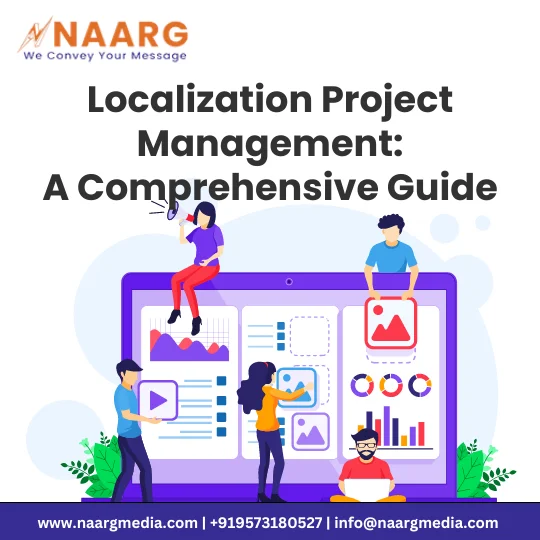Did you know that Coca-Cola changed the name of its product from ‘Coca-Cola’ to ‘Kekoukele’ in China, which translates to delicious happiness? This was particularly done to maintain the brand’s voice in the country while meeting the needs of consumers.
With localization and localization project management, businesses are no longer confined by borders. Businesses are expanding into new markets, which means reaching diverse audiences who speak different languages with unique cultural nuances.
Now this is where localization becomes crucial. However, localization project management is far from straightforward; it requires a deep understanding of the target market and the intricate processes involved.
For a successful global expansion, localization project management is the backbone of this strategy. It ensures that all the elements of your product or content resonate with the local audience.
Want to learn more about localization project management, the role of the localization project manager, and the risk management of projects? In this blog, we will tell you everything about localization project management and how a successful localization project can drive your brand’s international growth.

What is Localization Project Management?
It is the meticulous process of adapting content, products, or services to meet the cultural, linguistic, and regulatory requirements of a specific target market. And when it comes to localization, it goes beyond mere translation.
It involves a deep understanding of the local context to ensure that the end product remains relevant and resonates authentically with the local audience. Did you know that, according to a report by Common Sense Advisory, companies that invest in localization are 1.5 times more likely to experience an increase in revenue?
These statistics highlight the importance of localization project management in driving engagement and conversions. Effective localization project management is the key to successfully navigating all the localization challenges.
Thus, ensuring that your brand not only enters new markets but also thrives in them
The Role of a Localization Project Manager
A localization project manager plays a crucial role in the success of any global expansion effort. The localization project manager acts as a linchpin between various stakeholders, as they are responsible for orchestrating the entire localization strategy.
Ensuring that the content is not only accurately translated but also culturally adapted to resonate with the target audience. For this, the localization project manager must coordinate with linguists, designers, engineers, and marketing teams to maintain quality and consistency across all localized materials.
They should have a keen eye for detail and a deep understanding of both the source and target markets. A localization project manager ensures that deadlines are met, budgets are adhered to, and the final product is aligned with the brand’s global vision.
Their leadership and expertise are crucial in navigating the complexities of localization, making them an integral part of any organization that is looking to successfully engage with international audiences.
Planning Your Localization Project
For a successful localization project, it is essential to clearly define your goals and objectives, and according to that, you need to plan your localization project.
Listed below are some of the essential steps you need to take to plan your localization project.
1. Define the Project, Scope, and Objectives
To plan your localization project, always start by determining the specific regions or countries where you intend to localize your content. This will help you guide the language choices and cultural considerations.
Furthermore, clearly define what you hope to achieve through localization, like increased market penetration, customer engagement, or brand consistency across different regions. Also, it is essential to decide the content that needs to be localized.
Whether you are localizing an entire website, a specific set of documents, software, or multimedia content.
2. Assemble a Cross-Functional Team
It is essential to assemble a cross-functional team that looks after the localization project. For the cross-functional team, some of the essential team members include project managers, who oversee the entire localization process.
Linguists and translators who have expertise in the target language and industry. Cultural consultants to ensure that the localized content aligns with the cultural norms and values of the target market.
Lastly, a technical team can handle technical aspects like software localization, website integration, and the handling of localization tools.
3. Create a Detailed Project Plan
To create a detailed localization project plan, we need to set milestones and deadlines. For this, we need to break down the phases like content analysis, translation, cultural adaptation, and testing.
Then comes the next step: budget planning. We need to figure out the estimated costs for translation, tool subscriptions, testing, and team competition.
Finally, resource allocation is needed. allocation is needed to ensure that each team member knows their responsibilities and has the resources needed to perform their tasks efficiently.
4. Select the Right Localization Tools
Selecting the right localization tools is essential for any localization project. For this, you need to choose a translation management system that suits your project’s size and complexity.
This TMS will help manage translation workflows, track progress, and store translation memories. Also, it is essential to equip your translators with CAT tools that can help maintain consistency across translations and speed up the process.
Always use specialized localization platforms for software and website localization that support multiple languages and complex formats.
5. Conduct a Pilot Localization
To conduct a pilot localization, always choose a smaller, less critical market to test your localization process before a full-scale rollout. It will assist in spotting possible problems early on.
Make sure to start with a small, representative sample of your content to be localized. And ensure this content covers various formats, like text, images, and interactive elements.
Once the pilot localization is complete, gather feedback from native speakers and local experts. And assess both linguistic quality and cultural relevance. Then adjust the process based on the feedback.
6. Implement Full Localization
Once the pilot localization is successful, implement the full localization process. You can start with content localization, translate, and adapt the content based on feedback from the audience.
And ensure consistency in terminology and style across all content. Then comes cultural adaptation, which involves modifying visual elements like images, colors, and layouts to align with cultural preferences and avoid any potential misunderstandings.
Furthermore, technical integration is done. For this, you need to implement the localized content into your digital platforms. And ensure that the localized content is compatible with different devices and browsers used in the target markets.
7. Test and Validate the Localized Content
Once the localization process is complete, conduct thorough linguistic quality assurance checks to ensure the accuracy and fluency of the translation. It includes proofreading and editing by native speakers.
Then, for functional testing, test the localized content within its intended format to ensure everything works correctly. This will include checking for layout issues, broken links, and software functionality.
8. Launch and Monitor Performance
Once all the processes are complete, consider a soft launch where the localized content is released to a limited audience. And monitor for any immediate issues and rectify them before a full-scale launch.
Once you are satisfied with the soft launch, proceed with the full-scale launch across all target markets. Then, with the help of analytics tools, track the performance of the localized content. And monitor key metrics like user engagement, conversion rates, and customer feedback.
Risk Management in Localization Projects
As it might seem, the concept of managing a localization project may seem simple: just receive work, consider the budget and requirements, and then allocate resources. But in reality, it is not that simple. The risks of localization are way too high.
But don’t worry; we have listed some risk management points to implement for your localization projects.
1. Identify Potential risks Early
Try to identify potential risks at an early stage. In a localization project, one of the biggest risks is the potential for cultural misalignment, where visuals or content may be offensive or misunderstood in the target market.
Also, poor translation quality can lead to miscommunication, damaging your brand’s reputation, and leading to a loss of customer trust. Make sure to follow the regulatory compliance of the target country. Different countries have unique regulations, especially concerning data privacy, marketing, and advertising.
2. Develop a Risk Management Plan
To develop a risk management plan, always start by identifying all potential risks associated with the localization project. This includes both internal and external risks. And rank the risks based on their likelihood and impact.
Then focus on mitigating high-priority risks that could have the most significant effect on the project’s success. For each of the identified risks, develop specific strategies to either reduce, avoid, or manage the risks.
3. Ensure Quality Control Mechanisms
To ensure quality control mechanisms, implement multiple rounds of linguistic quality assurance that include proofreading, editing, and peer reviews by native speakers. You can use translation memory tools to maintain consistency.
Always engage local consultants or in-country reviewers to validate the content. This will ensure that the localization respects cultural norms and resonates with the target audience.
For effective localization project management, you need to have a keen understanding of both cultural and technical nuances. With the help of a structured approach, you can effectively navigate the complexities of localization. ensuring that your content resonates with diverse audiences across the globe.
Need a hand in localizing your project?
Feel free to contact us to learn more about our localization services.

